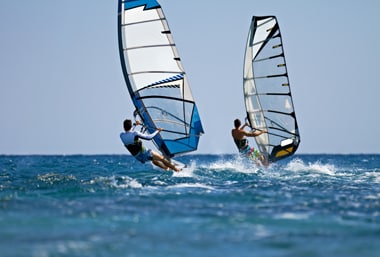What is Wind Surfing
Amalgamating the features of surfing and sailing, windsurfing is a watersport that is practiced on a ‘windsurf’ board (sometimes called a sailboard). The surfboard, usually between 2m and 5m, is powered along by the force of the wind on the sail. The board is attached to a rig by a universal joint that pivots freely; the rig is made up of the mast, mast base, boom and sail.
Uniquely, unlike a sailboat (which is steered by a rudder), the windsurfer is manoeuvred by the tilting and swivelling action of the mast and sail, and the listing and cutting motion of the board. Therefore, control of the surfboard depends as much on the individual’s mastery of the wind and water as it does on the conditions. Windsurfing is a more adventurous sport than sailing, one that requires higher levels of physical fitness and agility. A windsurfer sails and tacks faster than a sailboat, and one can handle higher wind speeds and exotic manoeuvres like jumping, neither of which is possible on a sailboat.
History of Windsurfing
In 1948, Newman Darby, 20, from the United States, designed a catamaran-like floating board on top of which he mounted a sail. In 1964, he made a universal joint to connect the mast of the rig to the ‘sailboard’. In a 1965 article, Darby called his idea ‘sailboarding’ – but never got down to patenting it. Not surprisingly, it was a couple of Californian dudes, sailor Jim Drake and surfer Hoyle Schweitzer, who picked up from where Darby had left off. In the 1960s, after much debate (Darby’s idea being unbeknown to them), they thought up the idea of a quirky crossbreed of sailing and surfing, an activity that combined the structure and gravitas of sailing with the breezy and laid-back vibes of surfing. Drake and Schweitzer patented the windsurfer in 1970 – but debate still persists whether it was the Californians or Darby (or, indeed, Englishman Peter Chilvers, or young Australian Richard Eastaugh) who should be credited with the invention of the windsurfer. Still, windsurfing caught on like wildfire. In the 1970s, the bug crossed the Atlantic. Soon, as the number of participants taking to the water swelled, a windsurfing tour (and other competitions) was launched. This was followed by the ultimate recognition – a place at the Olympic Games (Los Angeles, 1984).
Windsurfing in India
Indigenous windsurfing equipment hasn’t still reached international standards and one may have to import gear to attain a higher level of expertise (and competition). In India, windsurfing is mostly restricted to the Navy and Army sailing clubs, none of which are accessible to the general public. The only place where an enthusiast can learn windsurfing (and hire equipment) is on the beaches of Calangute and Candolim, in Goa. A watersports centre has recently come up on Mumbai’s Chowpatty beach (windsurfing equipment is available here). Organized courses are conducted at the National Institute of Watersports, at Caranzalem (near Panaji, Goa). In fact, training in the entire range of watersports is available at this institute (run by the Ministry of Tourism). However, the NIW is still at the project stage; training is organized only when a sufficient number of trainees have registered for a particular programme. Windsurfing equipment can be hired at the NIW, after one has demonstrated adequate expertise. The best places to go windsurfing in India are Goa’s beaches (Dona Paula, Calangute), and in Mumbai (off Cuffe Parade, Chowpatty, Juhu and Marve). One can also go windsurfing in the lakes/dams around Pune (Pawna, Panshet, Mulshi, Khadakwasla).
Equipment
The equipment required for windsurfing can be handled by a single person and is easily carried on a car top – fibreglass board, harness, harness line and joint.
Best season in India
All windsurfing takes place off the west coast of India, and the dry months – October / November to March / April – are generally the best time of the year to indulge in the activity.
Windsurfing sites in India
Goa
Lakshadweep
Mumbai
Pune
Tips
Choose an operator/outfit who observes stringent safety standards
Before setting out, check – and double check – your gear
Make sure you’re familiar with the international distress signal
Don’t set out in an offshore breeze!
Medical concerns
Windsurfing asks more of one’s physical fitness than sailing (it also requires one to be agile and quick-thinking!). It is obligatory to carry a medical certificate stating that the individual is medically fit.
Ecological concerns
Since the sport is practiced out on the water, there is little damage that surfers can do to the marine ecosystem. Nevertheless, respect the ocean – and don’t litter it!







 Share Via
Share Via




